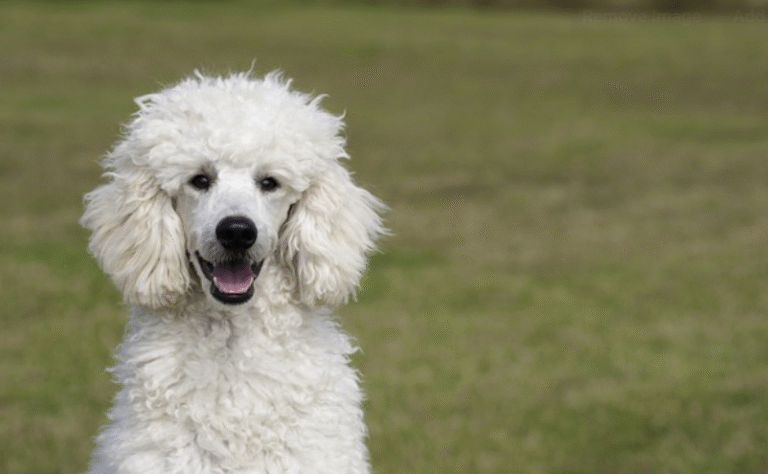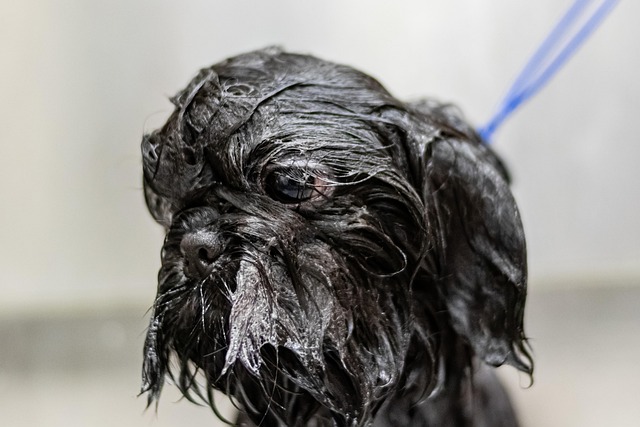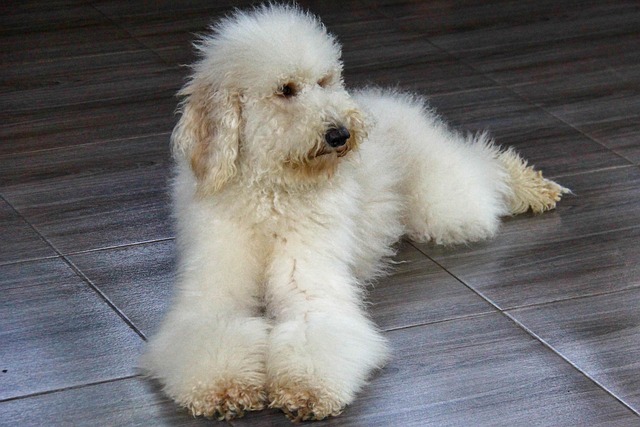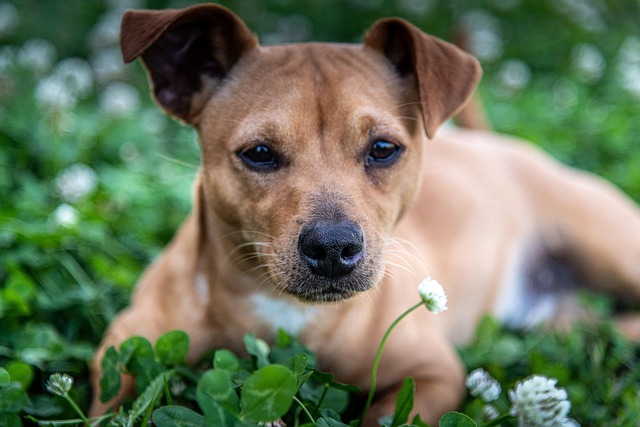Cavapoo puppies make wonderful family companions. They are a crossbreed between a Cavalier King Charles Spaniel and a Poodle and are beloved for their friendly disposition and soft, curly fur. Families with young children often select cavapoo puppies for their sweetness.
These dogs are smart, eager to please, and trainable, making them suitable for a variety of households. These dogs typically weigh 5 to 11 kilograms and require consistent grooming.
Whether you’re deciding on getting a cavapoo or raising your new puppy, important facts and advice you should know are outlined in the sections below.
Cavapoo Defined
A Cavapoo is a designer dog breed that mixes the Cavalier King Charles Spaniel and Poodle together. This cross has resulted in the best of both breeds. It’s no wonder Cavapoos are such a hit with families and singles!
Cavapoos are renowned for their gentle, loving, and playful temperaments. They’re ideal for every type of living space too, from a small apartment to a house with a yard.
1. Heritage
The Cavapoo’s story started in Australia back in the 1990s. A Cavapoo was intentionally bred to pull the best characteristics from a Cavalier King Charles Spaniel and a Poodle to create the ideal companion dog.
The intent was to bring together the Spaniel’s sweet, affectionate disposition with the Poodle’s cleverness and hypoallergenic fur. As news circulated about their friendly nature and hypoallergenic coats, Cavapoos quickly became a fad.
Today, Cavapoos are recognized by a number of dog clubs in their hybrid registries. This prestigious accolade further increases their visibility and fosters trust with prospective new owners.
2. Looks
The Cavapoo has a small, athletic body. Their wide, round eyes and furry cheeks can make their faces appear quite toy-like.
Coats can be straight, wavy or curly, again depending on whether they more closely resemble the Cavalier or the Poodle. Color colors can include cream, gold, chestnut, black, or tricolor.
Their long, silky ears to the side are a distinguishing trait, and they instantly lend the breed a soft, sweet expression. At around 4–11kg, Cavapoos are easy to hold and carry, and adapt well to apartment living or life in the city.
Cavapoos usually have a teddy bear cuteness. Other puppies have little tufts of fur around their mouths, or on their chins. This just adds to their charm and makes each one special!
3. Personality
Cavapoos are friendly, affectionate, and social. They want to participate in all aspects of life, from a stroll outdoors to a toy-filled play date indoors!
Because they are so gentle, they are great family dogs and thrive in homes with kids of all ages. Most Cavapoos are friendly towards strangers and can be good with other animals.
This friendly disposition makes them a wonderful choice for families that entertain often or have multiple pets.
Perhaps what makes them most unique, though, is how trainable they are. Cavapoos are usually fast learners when it comes to commands.
They are eager to please and respond excellently to positive reinforcement, so they are perfect for first-time dog owners or those wanting a dog to participate in agility or obedience clubs.
4. Longevity
Cavapoos live about 12 to 15 years. Regular health checkups help keep them happy.
Lifespan can shift with genetics, care, and lifestyle. It goes without saying that you need to take the long-term care of a Cavapoo into consideration.
5. Distinction
Hybrid vigor is what distinguishes Cavapoos from other breeds as they tend to be much healthier than their purebred dog counterparts.
They mix the Poodle’s intelligence and low-shedding coat with the Cavalier’s calm, loving temperament. This combination opens Cavapoos up to a wide range of potential owners, including active singles and busy families.
Over the past several years, the popularity of Cavapoos has increased dramatically, and their position as a designer breed continues to rise.
Essential Care

Like all cavapoo puppies, they do best with consistent routines and lots of positive, careful training. Their quality of life is greatly improved when their needs are addressed daily, not just for their health, but for their overall well-being.
Prospective owners must be prepared for both the everyday care and training and long-term commitment that will help create this special relationship.
- Brush coats daily or weekly, based on hair type
- Schedule monthly trims to prevent matting
- Clean ears and eyes frequently to prevent infections and staining
- Brush teeth every few days to avoid dental problems
- Provide 45–60 minutes of exercise per day
- Feed high-quality dog food on a set schedule
- Offer three to four small meals daily for puppies
- Watch weight to prevent obesity
- Visit the vet for regular checkups
Grooming
Cavapoos can have wavy or curly coats, with grooming requirements considered moderate to high. Daily brushing helps keep their fur soft and stops mats from forming, which is key for their comfort and skin health.
Pro tip: Skipping this step can create knots that are difficult to untangle, leading to discomfort or dermatological problems. Even just a simple monthly trim can help keep their coat clean and easier to handle.
Consistent grooming is an important way to detect skin issues or parasites early. Get them used to you touching their paws, ears, and face from a young age. Positive early routines will relieve some of the stress from the grooming process and will help dogs to accept care as they mature.
Fluffy coats thrive and shine under such consistent care, and clean ears and eyes lead to less infection or irritation. Tear stains may appear in some puppies and should be wiped regularly with a dog-safe solution.
Activity
Cavapoos are energetic dogs who keep a balanced lifestyle of play and relaxation. Most require at least 45–60 minutes of vigorous movement every day.
Short walks, fetch in the yard, and trips to the suburban dog park are perfect. They’re a perfect match for even the most active or tranquil households.
If there is not enough space or time outdoors, indoor games such as tug or chase will tire them out quickly. With high energy and a playful disposition, these dogs take exercise goals and turn them into a game for both dog and person.
Preventing obesity and keeping them active prevents wear and tear on their joints, maintains muscle tone, and strengthens the joints.
Diet
- Choose quality dog food with balanced nutrients
- Feed three to four small meals daily for puppies
- Stick to a routine to keep blood sugar steady
- Look for packages that list actual meat or fish as the first ingredient
- Avoid giving table scraps or foods high in fat
- Watch their weight and adjust food if needed
A continuous diet meets their great energy and growth needs, particularly during the first year. Consult your veterinarian for specific recommendations on what type of food to provide and the appropriate portion size.
Cavapoos with health issues such as dental problems or allergies may require more specific plans.
Health Focus

Cavapoo puppies can live long, healthy lives when owners know what to watch for and take steps to prevent problems early. These dogs can inherit the same health risks as those found in their parent breeds; therefore, knowing these is essential to keeping them happy and healthy.
Genetics, breeding, and all aspects of daily care contribute to their lifelong health.
Key Concerns
Cavapoos can face several health conditions:
- Heart disease, specifically Mitral Valve Disease (MVD), is prevalent due to their Cavalier King Charles Spaniel heritage.
- Vision-threatening eye issues, such as cataracts and progressive retinal atrophy, are common and cause blindness.
- Conditions such as hip dysplasia and patellar luxation can cause serious damage to their joints and hinder their ability to move.
- Syringomyelia is a painful condition that restricts a dog’s overall mobility.
- Dental disease is common, particularly in small breed dogs, and untreated dental disease can result in pain or infection.
Symptoms of these problems can be insidious at first. Be observant with your animals—look for symptoms such as coughing, difficulty walking, redness or cloudiness of the eyes, or a sudden change in feeding behavior.
Early detection is key to helping improve health outcomes. Annual or biannual check-ups go a long way towards preventing issues from developing into larger concerns.
Dogs with a known family history of heart disease or older dogs may require more frequent veterinary visits. Genetics play a big role—a responsible breeder will screen for these conditions to reduce risk.
Wellness Tips
- Bathe her teeth regularly and make an appointment for professional cleanings with your veterinarian.
- Provide a variety of nutritious foods and avoid excessive calories to reduce the risk of obesity.
- Provide regular, low-impact exercise, such as gentle walks or play, to help maintain joint health.
- Provide interactive mental games and toys to stimulate their brains.
- Schedule annual trips to the veterinarian for examinations, vaccinations and preventative health care.
- Look for pain or signs of sickness and respond early.
An ideal routine would be 60 minutes of walking, nutritious meals, and active play. In addition to regular walks, cavapoos require mental stimulation. Regular brushing keeps their coat shiny and skin healthy.
Vaccination is one of the most effective ways to protect against serious diseases. Preventative measures, such as flea and tick control, are just as important.
Keeping their skin clean and free of mats ensures that if a problem arises, it can be detected early on.
Health Risks Table
| Health Issue | Description | Prevention/Management |
|---|---|---|
| Mitral Valve Disease | Heart condition, often inherited | Regular vet checks, breeder screening |
| Eye Conditions | Cataracts, retinal issues, can cause blindness | Routine eye exams, breeder screening |
| Hip Dysplasia | Joint problem, inherited | Healthy weight, exercise, screening |
| Patellar Luxation | Knee cap slips, affects movement | Vet exams, weight control |
| Syringomyelia | Neurological pain disorder | Early vet care, careful breeding |
| Dental Disease | Gum disease, tartar, tooth loss | Daily brushing, dental cleanings |
Responsible Breeding
Responsible breeders test their breeding stock for potential inherited health problems, such as heart, joint, and eye diseases. This greatly reduces the risk for puppies.
Understand your Cavapoo’s ancestral medical history. Require documentation of health screenings.
Help raise awareness of the breed’s susceptibility to health issues. Don’t be afraid to ask questions at each vet visit.
Welcoming Home

Welcoming a Cavapoo puppy into your home is an exciting milestone! That’s why the first two weeks are so important to help them get acclimated. Creating a smooth start Smoothe home Make sure your home environment is safe, welcoming, and supportive of your new routine.
Cavapoos are bright, affectionate dogs who require time, patience, and love as they figure out the ropes.
Finding Sources
The first step is finding a reputable breeder or rescue organization. Regardless of a dog’s breed, always check to make sure a breeder follows humane and responsible breeding practices. Demand transparent health records and a clean environment for the dogs.
Above all, if possible visit the breeder in person. You’ll get a tour of the puppies’ living space. You should meet the parents, and you should ensure that the animals appear vibrant and healthy.
Adoption is a third, even better choice! There are Cavapoos available through most shelters and rescue groups, and their personnel can assist you in locating a puppy that meets your needs.
Puppy Choice
Choosing the best Cavapoo puppy involves observing their behavior with other puppies, rather than just appearance. Get to know the litter though! Watch each puppy’s temperament carefully—one may be outgoing, one timid, and some will want to hang near humans.
If you can, meet both parents together. This will help you get a clearer picture of what to anticipate in the puppy’s size, coat, and behavior. Help your puppy make a successful adjustment! A laid-back puppy would do well in a low-key home, and an energetic puppy would be better matched with a go-go, active family.
Home Setup
Make sure to have all the basics ready: food and water bowls, a comfy bed, and a crate or pen for when you can’t watch your puppy. Designate a calm area for your Cavapoo to recharge.
Avoid placing it near loud noises or a lot of foot traffic to ensure your pet has a comfortable space to relax. Pet-proofing is essential—remove all accessible cords, conceal or store all sharp objects, and confine access to multiple floors and hazardous areas.
Have some easy-to-replace toys, chew treats, and puzzle feeders ready to go. A variety of toys prevents boredom and entertains the puppy so that it does not start chewing on sneakers or telephone cords.
Routine and Training
Create a habit from the get-go. Try to feed your Cavapoo at the same time every day, typically three to four small meals for pups. Even short walks, playtime, and naps should have a predictable routine to them.
Early training is beneficial—in part, because Cavapoos learn quickly—they’re eager to please and catch onto commands quickly. There may be a few hiccups such as biting or the occasional mishap, but consistent guidelines and immediate positive reinforcement are most effective.
Thriving Together

An affectionate connection with a Cavapoo pup influences both actions and everyday happiness. These dogs truly flourish with the companionship and regular attention of their humans. They need both structure and warmth to grow into friendly, steady companions.
Positive reinforcement, collaborative playtime, and purposeful daily routines make ordinary experiences the foundation of a lifetime of trust. Cultivating companionship from an early age protects against many issues, such as separation anxiety and boredom, that can plague our pets.
Whether you live alone or have a large family, Cavapoos are the perfect fit as long as you can provide sufficient attention and mental stimulation.
Early Learning
| Tip | Description |
|---|---|
| Start young | Begin with short lessons from 8 weeks old |
| Keep it fun | Use toys, praise, and treats as rewards |
| Stay consistent | Repeat commands and routines every day |
| Socialize early | Introduce new people and pets regularly |
| Practice patience | Use calm voices, never harsh tones or punishments |
That last one is especially important, and early socialization is crucial. Even for naturally social Cavapoos, encountering a variety of folks and furry friends creates confidence and proper etiquette.
Take them to safe outdoor spaces, allow them to interact with guests, expose them to new sounds, locations, and unique experiences. This keeps them calm and open when they grow up.
Positive reinforcement is the most effective method we know for training and education. Reward with positive reinforcement! Give special foods, kind praise, or a beloved toy when she makes good decisions.
Cavapoos are quick learners and respond well to positive reinforcement, which will encourage them to repeat desirable behaviors. After all, consistency is key.
Maintain a predictable routine. When rules and rewards are consistent, Cavapoos are aware of what is required. This motivates them to trust and learn more quickly.
Social Skills
Cavapoos must be taught appropriate ways to come in contact with other animals and humans. Having good social skills reduces the likelihood of being fearful or timid as they develop.
Have friends over, go to local parks, or meet others in the neighborhood on foot. Cavapoos must be socialized. They ought to have frequent playdates with other canines to learn to develop comfort around new folks and animals.
These gatherings allow them to hone their etiquette skills and develop their social confidence. Puppy classes provide an excellent opportunity for controlled socialization with others in a safe environment.
Our professional trainers facilitate all play, ensuring that each dog is learning the appropriate behaviors expected in a pack. Take your puppy on walks along busy roads, to vet clinics, and on new surfaces such as grass or sand.
Each new creation turns the world into a safer, more exciting place.
Living Spaces
Cavapoos adapt well to various living spaces, whether you have a small apartment or a larger house. Their small size and personable disposition allow them to fit in almost anywhere.
Yet, they deserve and require space to recreate and roam. A comfy mat in a peaceful area provides them with a place to rest, and toys or puzzle feeders can help engage their minds.
We use daily walks and short games outside to help burn off that energy. They thrive when there are people around. If they aren’t given enough attention, they will become jittery or indignant.
Provide them with peers whenever you can. No matter what else, regular time outdoors is essential. It makes a difference not just by allowing for exercise, but providing new sights and smells that stimulate their minds, helping to keep them happy.
Beyond Basics

Cavapoo puppies are remarkable for more than their adorable appearance or small stature. They couple this sensitivity with a remarkable emotional intelligence with pragmatism to adapt. Their capacity to love humans runs deeper than a good cuddle session, earning them the title of the perfect pest-free pal for any household.
These dogs are typically very in-tune with human emotions and respond in kind, sensing the need for comfort or play. That oceanic emotional depth, combined with their flexibility across a variety of human habitats, makes them unique and irreplaceable among companion species.
Emotional IQ
Cavapoos exhibit emotional IQ in real world situations. When they’re feeling a change in mood—when you’re sad, they’ll sit nearby or nuzzle to you softly. During more anxious moments, a few Cavapoos remain close at hand, providing nonverbal reassurance.
They are lively and raucous like their owners when the mood is light, but behave subdued and serene in church. This flexibility hasn’t happened by accident. It develops as a result of the Poodle’s sensitivity mixed with the Cavalier’s loving nature.
As an example, a Cavapoo might pick up on a child’s anxiety. It is ready with a soft paw or furry snuggle to communicate empathy, even when words can’t.
Their calm disposition makes Cavapoos ideal candidates for therapy work. In hospitals or care homes, they provide solace through their peaceful presence. Pet parents can grow this bond by giving regular affection and attention, such as gentle petting or quiet sitting together.
Whether going for daily walks, eating meals together, or simply sitting in the same room, these simple, ordinary activities work to establish trust and develop the relationship.
Silent Signals
Cavapoos communicate using body language to express their emotions. A wagging tail, floppy ears, and a quiet whine all express happiness. On the other hand, hiding tails or yawning are signs of stress or discomfort.
One of the Cavapoos will poke you with their nose to request a play session. Some like to curl up at your feet, proving their devotion. Understanding these signals will help you make sure there’s no confusion.
Owners who pay attention to changes in how their puppy stands, moves or sounds will be able to better care for their pup. Responding to these signals—for example, providing a pause in playtime if the dog appears fatigued, or more room if they’re feeling overstimulated—builds their trust.
It works to prevent miscommunication that could result in anxiety or undesirable actions. Observation is the best way to learn a Cavapoo’s individual signals. Each one will have their own habits or quirks!
You may be familiar with the specific bark when they’re hungry or the excited twirl when it’s time for a walk. Recognizing these rhythms and dynamics is key to building a collaborative, mutually beneficial relationship.
Mind Games
Just like physical activity is important for a Cavapoo, so is mental exercise. Interactive puzzle toys, hide-and-seek with their treats and other engaging training games challenge their brains. Some Cavapoos love learning new tricks, while others prefer scent games or agility courses.
All of these activities go a long way to engaging their minds and energy, which is different from kid to kid. Regular interactive play keeps him out of trouble and can even serve to break stubborn streaks passed down from his Poodle lineage.
Training sessions combined with play, such as learning new commands or obstacle courses, develop skills while making learning enjoyable. For instance, a simple game of fetch becomes more challenging if you incorporate a “sit” or “stay” before each toss.
Adjusting the games to suit each dog’s energy level is essential. Some require high-energy sessions, while some prefer low-key mental challenges. Changing up activities and combining fun with a reward will help to keep your Cavapoo focused and entertained.
Conclusion
Cavapoo puppies can add an amazing energy and life to any home. They are loving and get on well with people of all ages! With proper treatment, these dogs remain cheerful and repay with tail wags and spirited gestures. Proper grooming, nutrition, and exercise make these dogs glow. Regular vet checkups are essential to keeping these small dogs strong and healthy. Basic measures make a big difference for their well-being.
Cavapoo puppies enjoy a brisk walk around the park or a leisurely pace through the city. With each passing day, they become more and more attached to their humans. For every household in search of a small, clever, and affectionate companion, a Cavapoo can make an excellent match. To find out, contact reputable local breeders or breed-specific rescue organizations and begin your search.
Frequently Asked Questions
What is a Cavapoo puppy?
A Cavapoo is a crossbreed dog, a mix between a Cavalier King Charles Spaniel and a Poodle. What is an adorable Cavapoo puppy like? These affectionate and playful pups have velvety-textured, hypoallergenic coats.
How much exercise does a Cavapoo puppy need?
Cavapoo puppies, known for their affectionate nature, require roughly 30 to 60 minutes of exercise per day. Regular walks, plenty of playtime, and ample mental stimulation will keep these adorable cavapoo puppies healthy and happy.
Are Cavapoo puppies good for families?
Cavapoo puppies are wonderful companions for families, known for their sweet temperament and friendly nature with kids and pets.
What grooming does a Cavapoo puppy require?
Cavapoo puppies, known for their adorable nature, require consistent brushing to avoid tangling and matting of their coats, making regular visits to a responsible cavapoo breeder essential for their health.
What are common health issues in Cavapoo puppies?
Cavapoos, beloved for their affectionate nature, are susceptible to heart problems and hip dysplasia, but many health issues can be avoided with regular vet check-ups and a nutritious diet.
How do I prepare my home for a Cavapoo puppy?
Set up a comfortable area for your adorable cavapoo puppy to sleep, complete with a bed, food and water bowls, and toys. Puppy-proof your home by removing dangers, and being consistent with a routine will help your new pet adjust to his environment quickly.
How can I help my Cavapoo puppy thrive?
Ensure balanced nutrition, plenty of daily exercise, socialization, and training using positive reinforcement techniques. With proper attention, your adorable cavapoo puppy will develop into a fine-natured friend.





